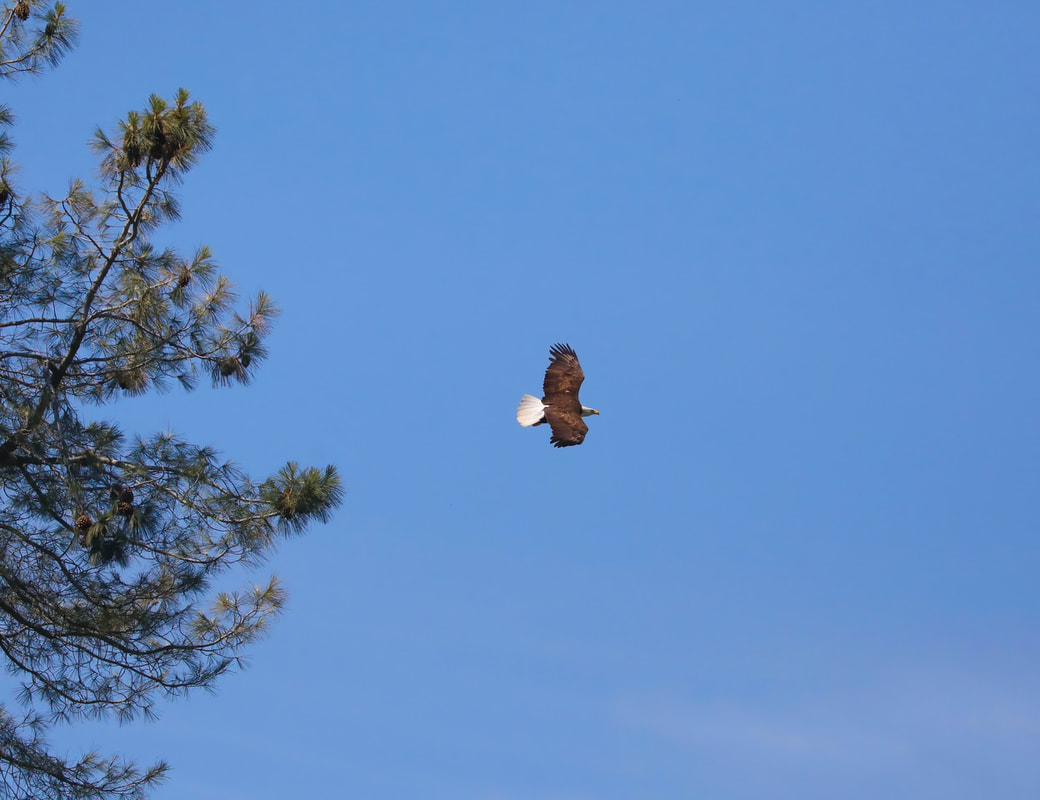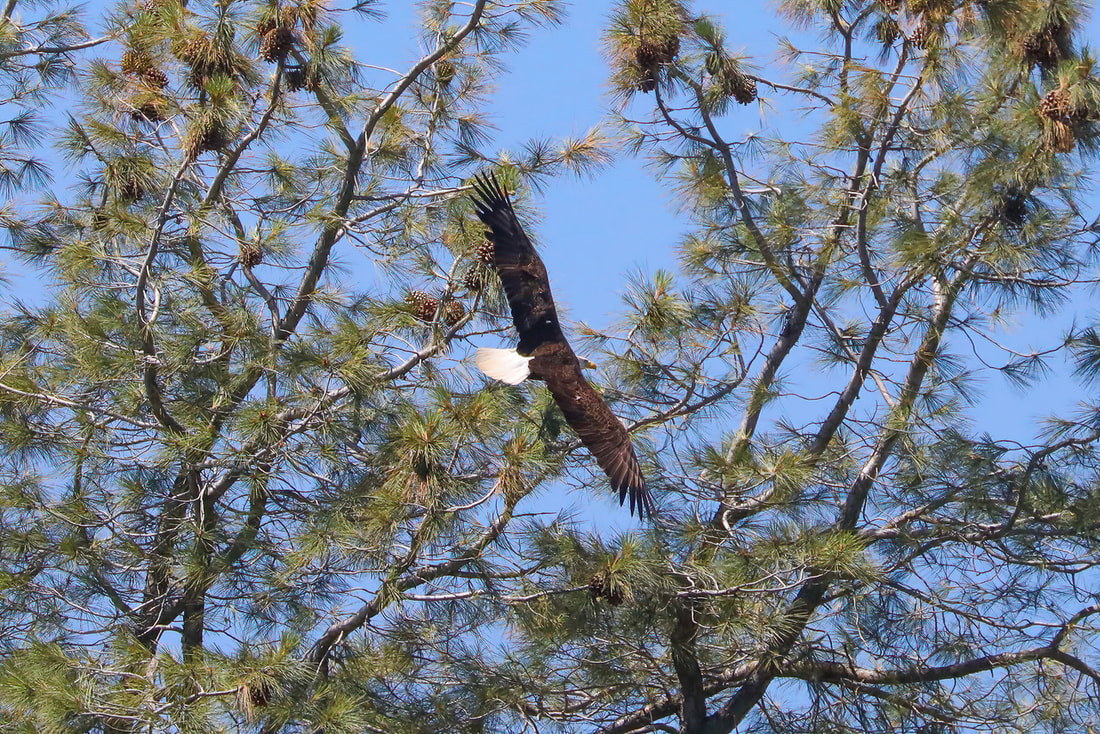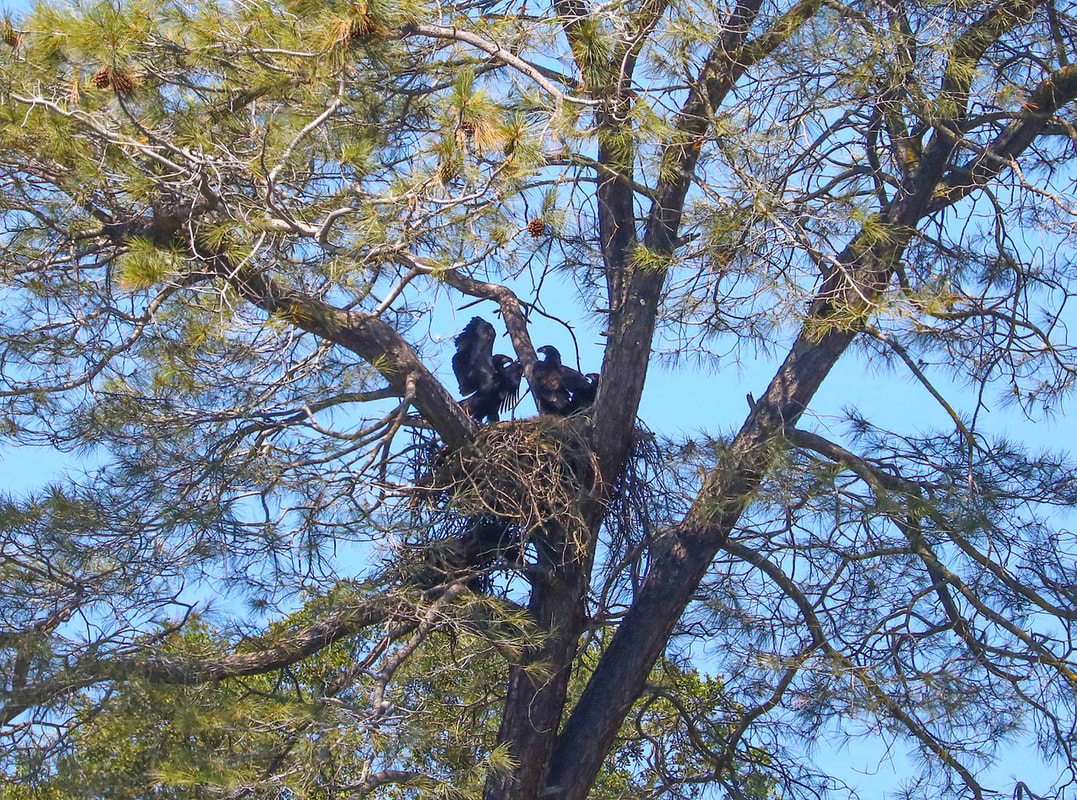Young eagles are called eaglets after they hatch while they are growing in the nest. When they take their first flight, they become fledglings. After they master take off and landings, they are juveniles eagles. After their first year, they are considered 2nd year, 3rd year, and 4th year eagles. Bald eagles become fully mature and both sexes have full white heads and tails in their 5th year. At that point they search for a mate and start their breeding cycle in a territory far away from their natal nest. Breeding Bald eagles have an approximate territory radius of 5 miles. While adult eagles are raising their eaglets, no previous year offspring or other eagles are allowed near the nest and will be screamed at and eventually chased away by the male.
Adult Bald eagles leave the area in late July after their juveniles leave the area to begin life on their own. They return in late September or early October and begin repairing their nest in earnest in November by gathering branches from across the lake and grasses from nearby open fields. They work on their nest at sunrise and usually stop around 8:30am - 9am. Sometimes they will also work on the nest in the afternoon. They then fly westward to no doubt hunt for salmon downstream. They have been seen flying with their previous offspring and perching together as well during this time. A breeding pair of eagles may remain together until the death of one member, and the surviving bird may soon find a new mate.
From late December until early February, they can be seen commonly mating frequently. According to US Fish and Wildlife, Bald eagle nesting season in this region begins the middle of January and that is when we begin monitoring and volunteer duties at the nest site. We strive to educate visitors that come out to see the eagles and take them to a designated viewing area (approximately 350’ west of the nest) to safely observe the eagles. Standing near an active nest during nesting season is considered disturbance to eagles per US Fish & Wildlife. Bald eagles are no longer a federally endangered species, but they are protected under the Federal Bald and Golden Eagle and Migratory Bird Treaty acts as well as being a California Endangered and a Fully Protected species under state law.
A female Bald eagle lays her eggs by the 2nd week or 3rd week of February and diligently incubates on them for about 35-38 days. The male eagle does relieve her but she is the primary brooder. The chicks hatch in the middle of March and are fed on demand for about three weeks. The male eagle is an ever diligent hunter and protector and will bring in fish after fish and an occasional mammal to the nest. This creates quite an odor attracting soaring Turkey vultures that circle the nest, not hunting the eaglets, but trying to scavenge the carcasses the male eagle brings in. When there are too many Turkey vultures circling the tree, the female eagle often screams. Sometimes the male will fly in to disperse the vultures as well. I am sure it causes the female eagle great angst when he does not come in right away.
Young eaglets are not able to thermoregulate to stay warm when they hatch so the female stays in the nest with them for about two weeks. Once they are covered in downy feathers, she no longer has to keep them warm.
The eaglets grow quickly as they must take their first flight in early June. After about a month or so, both adult eagles actively hunt to keep their growing eaglets satisfied. At about two months, food is not brought in as often as the eaglets would like. If they were fed on demand during this time, they would not be ready to fly in June! Thus begins what I call "Tough Love". The eaglets will squeal and squeal for food but the parents ignore them. They will be fed when the parents feel it is time and not when the eaglets want. I tell visitors that the only source of liquid they get is from the fresh kills their parents bring into the nest. Eagles have no way to bring in water so you can imagine how thirsty and hungry these eaglets might get.
In May, "Wingersizing" (exercising the wings or flapping) is done in earnest by the eaglets. By the end of May and early June, they will branch by jumping and flapping up to a nearby branch and going back down to the nest. This helps build up strength they need for that all important first flight. It should be noted that at this time, the eaglets look a bit bigger than their parents. The reason for this is that the parents begin to molt some of their feathers. The young eagles will not molt until the following year so they are always growing new feathers which gives them the appearance of being bigger.
The first flight of an eaglet is difficult to time but it is an exciting and nerve wracking moment. The nest has been the only home they have known for three months. When they first test their wings to fly it can be scary. I have seen them take their first flights and can tell you landing is very tricky. After about a week, they begin to get the hang of taking off and landing. The parents bring food into the nest for the juveniles for a couple of weeks. This forces them to fly back to the nest and practice the all important landing.
In July, the parents will bring food to different tree branches to get the juveniles familiar with their surroundings. Usually, by the end of July, they leave the area to live independently The parents then leave the area and head north to cooler climates. They are not tagged or otherwise tracked so we do not know exactly where they go. Sometimes, we see juveniles flying with Turkey vultures who are better at locating carcasses. The juveniles muscle their way in and eat their fill while the vultures wait. This is one way young eagles can survive while they practice their fishing and hunting skills. We must remember that eagles are scavengers as well as skilled hunters. They will happily eat carrion and freshly caught fish, birds, reptiles and mammals.
Nesting season is over by the end of July and our volunteer work is done until the following year.
I began volunteering for California State Parks and then for the Bureau of Reclamation in 2018 at the Lake Natoma nest and continue to do so. The Bureau of Reclamation owns the land where the eagles nest. In 2019, Friends of Lakes Folsom and Natoma (FOLFAN) organized a volunteer group that works in conjunction with State Parks to help at the nest site as there are increasing numbers of visitors that come out to see these beautiful eagles. A new brochure has been created to help address common questions about eagles: "New Friends of Lakes Folsom and Natoma Bald Eagle Brochure"
Due to the Governor’s order to Shelter in Place because of the pandemic, our volunteer efforts have been on hold since March. We hope to be back out as soon as the Shelter in Place order has terminated and it is safe to do so. Meanwhile, the eagles are doing what they have been doing successfully for a long time.
The status of Bald eagles in California and elsewhere continues to be very positive. Population numbers are increasing and pairs are returning to nest in areas they were missing from for many decades due to DDT and lead poisoning, loss of habitat, power line electrocutions, and shooting. The recovery of this species is a remarkable success story aided by the Endangered Species Act. With good stewardship and public behavior that should continue into the future.
Bald eagles in California



 RSS Feed
RSS Feed
